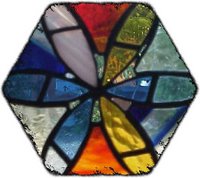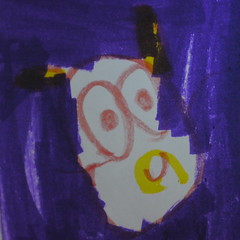Wednesday, September 26, 2012
Sunday, April 23, 2006
Course Insights

If you believe, as I do, that education is more than the transmission of content and learning is more than responding to a selected assessment tool, then you know that the experiences yielded from this last eight weeks in EME 5207 have been invaluable. The kaleidoscope of experiences to include Understanding by Design, online content, blogging (posting and conversations), and the building and sharing of technology rich-designed curriculum units has been very intense and extremely worthwhile as I continue to build on my understanding of creating excellent learning opportunities for students.
Though I commented on Dr. Dawson’s blog regarding specific issues, I wanted to share some other general thoughts that have evolved from taking this class…
I’m still intrigued by the curriculum model of UbD. It has a lot of depth of which I’ve yet to tap – even some of the more “obvious” sections are difficult to apply. For example, ‘thinking like an assessor’ begs for authentic assessment, just as problem based learning is best assessed with a rubric. The very nature of authentic assessment, to include rubric tools, dictates subjectivity and yet the accountability process usually desires objectivity. Even when you think of FCAT Writing, there is a rubric for scoring, but look at the criteria cells and much is subjective – which is, of course why there are multiple graders. So, how do we best balance these issues? I know for my curriculum unit’s PBL, I included a rubric – some of the criteria is clearly objective with quantitative measures, but almost all still has a subjective flavor. Though planning to discuss the rubric’s subjectivity and examples prior in conjunction with the PBL, as well as including peer- and self-assessments using the rubric, I still wonder if I’ll be able to measure the desired results in the intended ways of UbD.
Using blogs for this class (and others) has so much learning potential! It is a different kind of learning, more reflective in nature, than many have experienced. Because of that it is sometimes frustrating, confusing and resisted, but they offer such a personal and public (I know that sounds so contradictory!) platform for thinking about learning. Do we not owe it to ourselves to develop independent learning skills, as well as nurture that in our students? Struggling with concepts, demonstrating skills, ‘thinking outloud’ and connecting with others around the world are daily occurrences in the world of blogging. Though I would hope that could also be said about our typical classrooms, my experience tells me otherwise. So, not only will I continue to blog and read my ever-growing list of edubloggers’ posts, but I will introduce others, including students, to this format. Of course, there are legitimate concerns (to include privacy and safety, AUPs, etc.) that need to be addressed (my most significant one now is finding an effective tool that feeds me comments in addition to postings), but that should not create a barrier worth problem-solving. Also, with the rapid increase in Web 2.0 tools, I’m betting that the next generation of blogging (and yes, I believe it is here to stay!) will offer even more for learning!
Technologies and our changing world continue to impact education and learning. Moving beyond the mere transmission of content to the understanding of information and concepts and then on to the construction of knowledge demands that we continue to think about how we are learning and teaching…and more significantly how we will apply those changes and influence others to do the same.
Saturday, April 22, 2006
Transforming...
Social software and web 2.0 are new terms that are being tossed about in the realm of educational technology these days. I’ve not only defined them (social software, web 2.0), but I’ve used them on a daily basis in the last four months, and I’m still not sure I truly understand the depth of their meaning nor their influence. That feeling is both disappointing and challenging, but it seems my neurons keep flashing in so many chaotic directions that I can’t corral my thoughts for a succinct concept.
The reason this appears so urgent is that these new ideas not only transform our present and future way of life in general, but they absolutely need to be a part of our curriculum and learning environments now! Alexander (2006) writes of using social bookmarking in post secondary education (among other things – great article) and I wonder how many people are even aware of del.icio.us, much less use it (or similar tool) to its full advantage. Add on tagging and RSS feeds to the basic concept and there’s a whole new world of resources and potential conversation – what a springboard for learning and understanding! This is only the tip of the iceberg as one explores the tools of blogs (check out this post about the future of blogging!), wikis, other collaborative writing tools (i.e., writely) to create and construct knowledge and understanding.
Alas, there are danger warnings that accompany these tools. For example, students need to have some parameters in creation – to include recognizing the public nature of social software (it is so very easy for all of us to view the contents of the computer screen as private when in fact the opposite if web-based) and making appropriate decisions regarding the use of knowledge-builders (i.e., privacy, safety and copyright issues). But can we as educators continue “business as usual” when our society is undergoing such a transformation? As mentioned in my introduction, I know I don’t have complete understanding (and maybe never will), but I know that as educational leaders we need to explore these tools and continue to keep our eyes on the horizon for emerging technologies that will influence our world (and our students)!
Alexander, B. (2006). Web 2.0: A new wave of innovation for teaching and learning? Educause Review. 41, (2), pp. 32-44. Retreived April 9, 2006 from http://www.educause.edu/apps/er/erm06/erm0621.asp
The reason this appears so urgent is that these new ideas not only transform our present and future way of life in general, but they absolutely need to be a part of our curriculum and learning environments now! Alexander (2006) writes of using social bookmarking in post secondary education (among other things – great article) and I wonder how many people are even aware of del.icio.us, much less use it (or similar tool) to its full advantage. Add on tagging and RSS feeds to the basic concept and there’s a whole new world of resources and potential conversation – what a springboard for learning and understanding! This is only the tip of the iceberg as one explores the tools of blogs (check out this post about the future of blogging!), wikis, other collaborative writing tools (i.e., writely) to create and construct knowledge and understanding.
Alas, there are danger warnings that accompany these tools. For example, students need to have some parameters in creation – to include recognizing the public nature of social software (it is so very easy for all of us to view the contents of the computer screen as private when in fact the opposite if web-based) and making appropriate decisions regarding the use of knowledge-builders (i.e., privacy, safety and copyright issues). But can we as educators continue “business as usual” when our society is undergoing such a transformation? As mentioned in my introduction, I know I don’t have complete understanding (and maybe never will), but I know that as educational leaders we need to explore these tools and continue to keep our eyes on the horizon for emerging technologies that will influence our world (and our students)!
Alexander, B. (2006). Web 2.0: A new wave of innovation for teaching and learning? Educause Review. 41, (2), pp. 32-44. Retreived April 9, 2006 from http://www.educause.edu/apps/er/erm06/erm0621.asp
Thursday, April 13, 2006
On the Lighter Side...
Check out this article in the New York Times! Can you relate? I can – screensucking and frazzing my way through the day! Though I’m not guilty of being a cellopain, I have suffered from logonorrhea! :-)
Monday, April 10, 2006
Podcasts and Wikis and Blogs - Oh My!
The past couple of months have been a blinding compilation (at warp speed mind you!) of so many new technologies (podcasts, wikis, and blogs) and so much fresh and provocative information (from my RSS feeds of currently 121 blogs) that I wonder how I survived in 2005! And that doesn’t even include my experiences at FETC and our own class blogs! So much in so little time and yet it is surely a reflection of Moore’s law and of today’s flat world … furthermore, as an instructor of basic EME 2040, I am not content to teach yesterday’s content nor process (despite my ‘old’ age).
There are two items that seem quite noteworthy in my readings (and listenings!) today that I feel compelled to share, especially in light of Linda’s post about blogging. One is David Warlick’s post on his presentation to the National School Board Association (thank goodness they are paying attention – or at least putting him on the agenda!). I strongly advocate listening to his interview (podcasted by Tim Wilson) as well as to investigate 21st Century Learning Skills (there’s a link to Ken Kay’s speech, as well) if you’re not already familiar. Much of what is said not only emphasizes the new technologies, but more importantly spells the new world – which none of us really know, but more importantly all of us must consider as we think about learning, teaching and education. Our students, our children will not function in the “conceptual” age if we continue to teach in the industrial age and more than likely continue to operate our school calendars in the agricultural age.
OK, before I get off my soapbox…there’s another article that gives some tips for addressing the right side of the brain skills that Web 2.0 and the conceptual age seem to be serving. Doug Johnson’s article in Education World may also assist us as we find relevant learning plans for our curriculum units!
There are two items that seem quite noteworthy in my readings (and listenings!) today that I feel compelled to share, especially in light of Linda’s post about blogging. One is David Warlick’s post on his presentation to the National School Board Association (thank goodness they are paying attention – or at least putting him on the agenda!). I strongly advocate listening to his interview (podcasted by Tim Wilson) as well as to investigate 21st Century Learning Skills (there’s a link to Ken Kay’s speech, as well) if you’re not already familiar. Much of what is said not only emphasizes the new technologies, but more importantly spells the new world – which none of us really know, but more importantly all of us must consider as we think about learning, teaching and education. Our students, our children will not function in the “conceptual” age if we continue to teach in the industrial age and more than likely continue to operate our school calendars in the agricultural age.
OK, before I get off my soapbox…there’s another article that gives some tips for addressing the right side of the brain skills that Web 2.0 and the conceptual age seem to be serving. Doug Johnson’s article in Education World may also assist us as we find relevant learning plans for our curriculum units!
Sunday, April 09, 2006
Curriculum Unit - UBD: Stage 3
Continuing the curriculum planning for my unit on Ethical, Legal and Social Issues, I’ve selected a number of learning activities to meet the desired results and assessment evidence. In addition, I’ve incorporated technology as a supportive tool to enhance the activities. There are many web sites that supplement the textbook readings and provide not only updated and in-depth information but also applicable examples. I’ve also included a model WebQuest, blogs, wikis, technology productions tools (word processing and/or publishing, PowerPoint) and online quizzes.
Please note that since this is college-level course, many of the activities will be done outside of the allotted class time – in planning this unit, I’m using the old formula (that is often a ‘joke’) of expecting students to spend 2-3 times the amount of time outside of class as during class time.
Learning Activities
Please note that since this is college-level course, many of the activities will be done outside of the allotted class time – in planning this unit, I’m using the old formula (that is often a ‘joke’) of expecting students to spend 2-3 times the amount of time outside of class as during class time.
Learning Activities
- Hook with a typical educational technology scenario demonstrating legal, ethical social and human issues. (H)
- Pose the essential questions and the culminating problem-based learning scenario and expectations (W)
- Use KWL to assess knowledge of legal and ethical issues
- Read applicable sections in textbook on Copyright, Fair Use and Plagiarism and on the following websites: (E1)
- U.S. Copyright Office
- Using the Internet in Education: Copyright Laws (UF EME 5405 Spring 2006 wiki)
- Creative Commons
- University of Texas Crash Course in Copyright
- Wired: The Economy of New Ideas
- The New Plagiarism (Jamie McKenzie)
- CyberBee - Role-play Point/Counterpoint: Students will debate “Copyright v. Copywrong” via groups of Pros, Cons, and Judges (E-2, R)
- Take and submit online Quizzes (E, R)
- The Educator’s Guide to Copyright and Fair Use (Hall Davidson)
- What is Plagiarism? (Indiana University) - Blog and comment on one other’s post: How does what you’ve learned about copyright, fair use and plagiarism impact your role as a teacher in the classroom? (R)
- Read applicable sections in textbook on Privacy, Ethics and Acceptable Use Policies and on the following websites: (E1)
- Using the Internet in Education: Internet Safety (UF EME 5405 Spring 2006 wiki)
- Center for Safe and Responsible Internet Use
- wiredsafety.org
- Internet Safety for Schools
- The Internet Safety Debate
- Child Safety on the Information Highway (Lawrence Magid) - Explore and discuss Playing it Safe (a WebQuest about Internet Safety by Stacy LeFevre) –
- Design a handout or brochure for parents regarding Internet safety and privacy issues (E, T)
- Research Acceptable Use Policies – AUPs (E)
- Develop own classroom AUP (E, R)
- Read applicable sections in textbook on Diversity and Access and on the following websites: (E1)
- Using the Internet in Education: Digital Divide (UF EME 5404 Spring 2006 wiki)
- Digital Divide (Wikipedia)
- Toward Equality of Access - Review PowerPoint presentation on Social and Human Issues: Diversity & Access (E1)
- Blog and comment on one other’s post: Respond to “muddiest point” from PowerPoint presentation and discussion (E, R)
- Work on Problem-Based Learning scenario with group members (E, R)
- Present PBL results (to include wiki for collaboration). Peers and self complete rubric for assessment. (E2, T)
- Complete "L" of KWL - what you have learned in blog (R)
Saturday, April 08, 2006
The Big Picture - UBD Readings
I think I would have benefited from reading Chapters 12 & 13 at the beginning instead of the end (backwards again)! This ‘big picture’ really puts into perspective the concept of understanding by design. The example of a grade level history curriculum (Wiggins & McTighe, 2005, p. 277) and the schematic of a district level inter-disciplinary structure (p. 278) frames the entire model. The focus on essential questions really shines through and centralizes those higher-level thinking skills in a uniting fashion.
Through out the book (and workbook), the authors have exemplified their framework in various content examples, which are especially helpful for those who need to “unlearn.” One of their quotes I like, “Whatever the subject, we learn best by going through many part-whole-part learning cycles – trying it out, reflecting, adjusting. We learn just enough content to be able to use it, and we make progress by tackling increasingly complicated ideas and aspects of performance” (p.292).
Since I’m a huge proponent of “transferability” and the practical, real-world application of subject matter, I’ve focused on designing relevant learning activities. However, my purpose in designing curriculum has never consciously been geared toward the essential questions and big ideas. In reflecting on my readings and unit planning with this in mind, I expect I’ll be re-designing my course with UBD as a springboard. Thinking about the work is both exhausting and exhilarating, but terribly important as I attempt to model effective learning principles in a class for perspective teachers.
Wiggins, G. & McTighe, J. (2005). Understanding by design (2nd ed). Alexandria, VA: ASCD
Through out the book (and workbook), the authors have exemplified their framework in various content examples, which are especially helpful for those who need to “unlearn.” One of their quotes I like, “Whatever the subject, we learn best by going through many part-whole-part learning cycles – trying it out, reflecting, adjusting. We learn just enough content to be able to use it, and we make progress by tackling increasingly complicated ideas and aspects of performance” (p.292).
Since I’m a huge proponent of “transferability” and the practical, real-world application of subject matter, I’ve focused on designing relevant learning activities. However, my purpose in designing curriculum has never consciously been geared toward the essential questions and big ideas. In reflecting on my readings and unit planning with this in mind, I expect I’ll be re-designing my course with UBD as a springboard. Thinking about the work is both exhausting and exhilarating, but terribly important as I attempt to model effective learning principles in a class for perspective teachers.
Wiggins, G. & McTighe, J. (2005). Understanding by design (2nd ed). Alexandria, VA: ASCD





